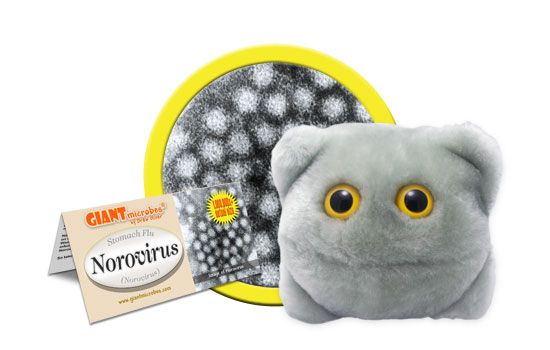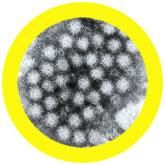Norovirus (Norovirus)
Product Details
Additional Information
| Sizes | Giantmicrobes are based on actual microbes, cells, organisms and other critters, only 1,000,000 times actual size! Gigantic (GG) 16-24" XL (XL) 10-15" Original (PD) 5-8" Keychain (KC) 2-4" with clip |
|---|---|
| Materials | Plush from all new materials. Stuffed with polyester fiber fill. Surface washable: sponge with water & soap, air dry. |
| Packaging | Each plush microbe includes a printed card with fun, educational and fascinating facts about the actual microbe or cell. |
| Safety | Every product meets or exceeds U.S. and European standards for safety. For ages 3 and up. |
All about Norovirus (Norovirus)
FACTS: Norovirus is the most common cause of non-bacterial acute gastroenteritis, or stomach flu. While it can be found in a variety of food products (and is often found on leafy greens and fresh fruits), it is particularly fond of shellfish. In fact, Norovirus is the signature causative agent of bad clams or oysters, and its handiwork more than justifies the adage that raw shellfish should be avoided in the hot summer months (those without an "r").
Because it is highly contagious, Norovirus is commonly found in day care centers, nursing homes, schools, and other locales where population-density is high. But it also has a particular penchant for travel and often makes news as a stowaway on cruise ships where passengers are in close quarters with one another – and where the nautical setting tends to put shellfish on the menu.
The virus is fast-acting and usually announces that it’s in port within a day or two after arrival. Fortunately, its intestinal escapades are generally short-lived, and the virus usually re-embarks after a few regrettable days.
Nevertheless, Norovirus is quite hardy and can survive for days or weeks on contaminated surfaces (which also contributes to its spreadability). Washing your hands with soap is an effective means of warding off infection, though alcohol-based solutions are less effective as Norovirus is not packaged in a lipid viral envelope.
So take precautions and steer clear of the rolling seas…
| Name | Originally called the Norwalk virus because Norwalk, Ohio was the place of the first confirmed outbreak. Norwalk-like virus turned into Norovirus for simplicity. |
|---|
| Where It Lives | People contract Norovirus by getting the virus in the eyes, mouth, or nose, which is caused by contact with infected people or surfaces and contaminated food or water. Cute gift for pediatricians! |
|---|
| Symptoms | Inflammation of the stomach/intestines, causing pain, nausea, and diarrhea. Dehydration is often a result. |
|---|
| Cure | People typically get better within 1-3 days. It cannot be treated with antibiotics because it is a viral infection. Infected people should drink fluids to prevent dehydration. |
|---|
| History |
1929: Zahorsky described the stomach inflammation associated with this disease as the “winter vomiting disease.” 1972: The agent causing this stomach inflammation, the Norovirus, was discovered. Big Outbreaks: 1968: Norwalk, Ohio had the first confirmed Norovirus outbreak. Recent Outbreaks: Cruise ships are known for the spread of Norovirus, and there are many incidents yearly. April 2015: >100 people on a cruise ship got Norovirus. |
|---|
| Fascinating Facts |
Nicknames: Sometimes Norovirus is called ‘food poisoning’ or ‘stomach flu’ even though other things can also cause food poisoning, and Norovirus is not the influenza (hyperlink) virus. Widespread: It is the most common cause of acute gastroenteritis and foodborne illness outbreaks in the U.S. with about 21 million illnesses a year and 570-800 deaths. Cruise Ships: Norovirus spreads rampantly on cruise ships because of the close quarters. Watch out on the water, or you might get sea-sick. Famous People Who Had Norovirus: Bret Michaels canceled a concert in Pennsylvania because of a Norovirus infection. |
|---|






